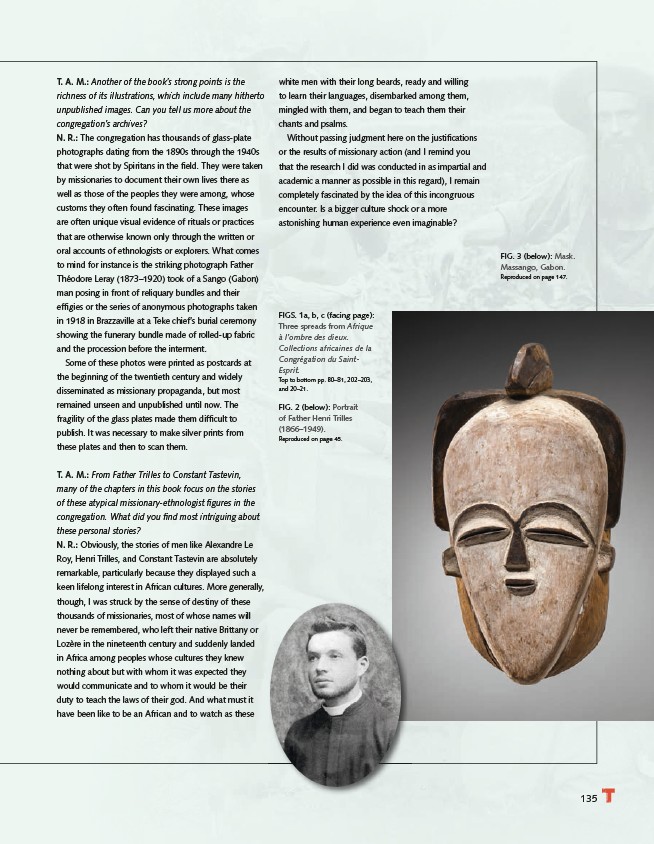
135
FIG. 3 (below): Mask.
Massango, Gabon.
Reproduced on page 147.
FIGS. 1a, b, c (facing page):
Three spreads from Afrique
à l’ombre des dieux.
Collections africaines de la
Congrégation du Saint-
Esprit.
Top to bottom pp. 80–81, 202–203,
and 20–21.
FIG. 2 (below): Portrait
of Father Henri Trilles
(1866–1949).
Reproduced on page 45.
T. A. M.: Another of the book’s strong points is the
richness of its illustrations, which include many hitherto
unpublished images. Can you tell us more about the
congregation’s archives?
N. R.: The congregation has thousands of glass-plate
photographs dating from the 1890s through the 1940s
that were shot by Spiritans in the fi eld. They were taken
by missionaries to document their own lives there as
well as those of the peoples they were among, whose
customs they often found fascinating. These images
are often unique visual evidence of rituals or practices
that are otherwise known only through the written or
oral accounts of ethnologists or explorers. What comes
to mind for instance is the striking photograph Father
Théodore Leray (1873–1920) took of a Sango (Gabon)
man posing in front of reliquary bundles and their
effi gies or the series of anonymous photographs taken
in 1918 in Brazzaville at a Teke chief’s burial ceremony
showing the funerary bundle made of rolled-up fabric
and the procession before the interment.
Some of these photos were printed as postcards at
the beginning of the twentieth century and widely
disseminated as missionary propaganda, but most
remained unseen and unpublished until now. The
fragility of the glass plates made them diffi cult to
publish. It was necessary to make silver prints from
these plates and then to scan them.
T. A. M.: From Father Trilles to Constant Tastevin,
many of the chapters in this book focus on the stories
of these atypical missionary-ethnologist fi gures in the
congregation. What did you fi nd most intriguing about
these personal stories?
N. R.: Obviously, the stories of men like Alexandre Le
Roy, Henri Trilles, and Constant Tastevin are absolutely
remarkable, particularly because they displayed such a
keen lifelong interest in African cultures. More generally,
though, I was struck by the sense of destiny of these
thousands of missionaries, most of whose names will
never be remembered, who left their native Brittany or
Lozère in the nineteenth century and suddenly landed
in Africa among peoples whose cultures they knew
nothing about but with whom it was expected they
would communicate and to whom it would be their
duty to teach the laws of their god. And what must it
have been like to be an African and to watch as these
white men with their long beards, ready and willing
to learn their languages, disembarked among them,
mingled with them, and began to teach them their
chants and psalms.
Without passing judgment here on the justifi cations
or the results of missionary action (and I remind you
that the research I did was conducted in as impartial and
academic a manner as possible in this regard), I remain
completely fascinated by the idea of this incongruous
encounter. Is a bigger culture shock or a more
astonishing human experience even imaginable?